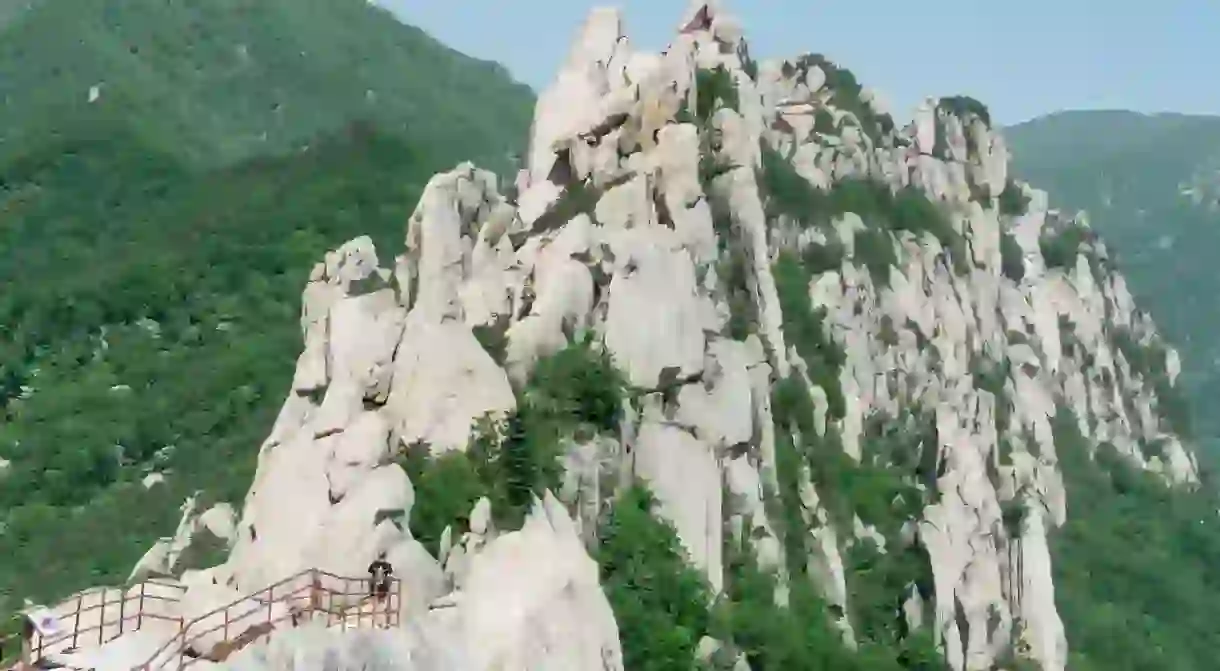A Guide to Visiting Seoraksan National Park, South Korea

Seoraksan is one of Korea’s most beautiful mountains. Seoraksan National Park is the surrounding area, famous for its views, clear mountain streams and vibrant flora and fauna. Hiking is a much-loved pastime all across Korea, and Seoraksan boasts some of the loveliest trails in the country. Here’s our guide to visiting the park.
Seoraksan Mountain
Natural Feature

Located in the northeast of Korea, Seoraksan Mountain reaches a height of 1,708 metres (5,604 ft) at its highest point, Daecheongbong Peak. It’s Korea’s third largest mountain and has a variety of hiking trails, most of which take only a few hours to complete. Scenery includes cliffs, waterfalls and lots of natural beauty. Seoraksan translates to ‘Snowy Peaks Mountain’.
Seoraksan National Park
The park itself spans four cities and counties, and has an area of 163.6 square kilometres (63 sq mi). It’s one of Korea’s most iconic parks, and was the first area to be designated as a national park by the Korean government, in 1970. It has been a UNESCO Biosphere Protection site since 1982. As well as Seoraksan, the park has a number of smaller mountains and hills, totalling 30 peaks overall. Ulsanbawi Rock is a famous rock formation made of six granite peaks, which is popular with visitors.


Seoraksan’s cultural sights
Within the park are two Buddhist temples, Baekdamsa and Sinheungsa. Both are of historical interest, and set in areas of great natural beauty. Sinheungsa is believed to be the oldest Seon temple in the world, and is now a head temple of the Jogye Order of Korean Buddhism. Baekdamsa’s name translates to ‘Hundred Pool Temple’, referring to the hundred pools set around the temple complex, which are fed by clear water from the slopes of Daecheongbong Peak.


Seoraksan’s flora and fauna
Seoraksan National Park is a UNESCO Biosphere Protection site, and has been designated as a nature reserve since 1965, in part because it’s home to many plants and animals, including a number of rare ones – more than one thousand species of plants and 1,562 animal species have been identified within the park. Lucky visitors can catch a glimpse of the increasingly rare Korean musk deer and Korean goral here, as well as animals including otters, Siberian flying squirrels, and perhaps even an Asian black bear.




Seoraksan Cable Car
If trudging up hills on foot isn’t quite your cup of tea, you can head up the mountain and take in some breathtaking views on the Seoraksan cable car. The car goes all the way up to Gwongeumseong Fortress, a ruined stone edifice perched at the top of Seoraksan Mountain.




Geumganggul Cave
Head up the steep slopes of Seoraksan Mountain – about 600 metres (2,000 ft) up – and you’ll come to Geumganggul Cave. This small cave was once used as a site of worship and is still well maintained today. The cave opening looks out over spectacular views and is well worth the hike up to reach it.


What to do on a first visit to Seoraksan
For spectacular scenery, stay in the Outer Seorak (Oeseorak) area, which is home to Ulsanbawi Rock and Geumganggul Cave, as well as enormous waterfalls including Biryong Falls, Oryeon Falls, and Towangseong Falls. This region is also close to facilities, hotels and shops in Seorak-dong. The two most popular hiking trails go from Biseondae to Madeungryeong, and from Biseondae to Daecheonbong Peak via Cheonbuldong.




How to get to Seoraksan National Park
Seoraksan National Park is three hours by car from Seoul, making it a very doable day trip. Public transport is a little trickier but still possible – you can take a bus from the Seoul Express Bus terminal or Dong Seoul terminal to to Sokcho city, which should take you approximately four hours (including a 20-minute rest stop in the middle). From Sokcho, you can take local bus number 7 or 7-1 to Outer Seorak (Oeseorak), which will take approximately 30 minutes.
















